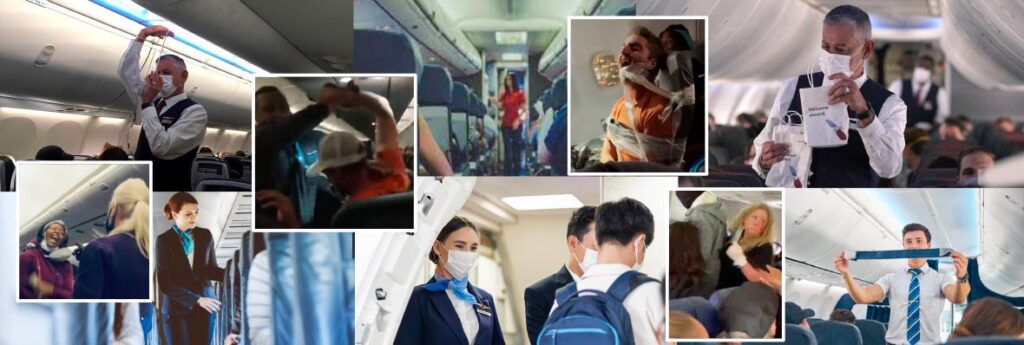Flight attendants are effectively forced to work for free amid growing tarmac delays – particularly at Toronto’s Pearson airport – according to the Canadian Union of Public Employees, which represents some 15,000 flight attendants. CUPE says the clogged airports and lengthy wait times that have plagued thousands of passengers in recent weeks are also extracting what amounts to unpaid labour from cabin crews.
Flight attendants are typically compensated based on time in the air, so hours spent on the tarmac tending to frustrated travellers yields no extra wages in some cases, while other collective agreements allow for half pay. The problem, most acute at Canada’s largest airport since late last month, plays out after planes land and then sit for up to three hours at the gate, said Wesley Lesosky, who heads CUPE’s airline division.
“They’re actively doing water service, helping people. The cabins are getting hot, because obviously they’re on the ground … they can be tending to ensuring the aisles are clear, doorways are clear,” he said in a phone interview from Victoria.
“For Air Canada Rouge, there’s zero pay, zero compensation for them. For Air Canada, it’s a 50 percent credit if the service director claims it.”
The on-the-ground work can be even more taxing – and occasionally abusive – than service in the sky, he added.
“We’ve definitely seen a huge increase in irate customers, and just health and safety issues in general for cabin crew.”
Time on board also eats into employee downtime between flights, potentially contravening contract provisions.
Former Air Canada chief operating officer Duncan Dee, said this is a potential problem for airlines as well, citing both collective agreements and aviation regulations.
“If flights are routinely delayed and crews are unable to meet their minimum crew rest then a cascading effect happens where subsequent flights are delayed, not only because the plane is arriving late, but because crews must have a minimum number of hours to rest after a full duty day.”
Even half-time pay for tarmac delays could also wind up costing carriers a bundle, he added.
Lesosky says airlines and federal agencies need to hire more staff to improve the flow of passengers and that an “outdated” system of compensation must be reformed.
Airports, particularly in Toronto and Vancouver, have seen hours-long security queues, customs bottlenecks and other delays due to random COVID-19 testing as passengers return to the skies en masse following more than two years of pent-up demand.
The union spoke with Air Canada Rouge representatives Thursday afternoon, and planned to discuss the labour issues with Air Canada management later in the day, Lesosky said.
The WestJet Group is hoping to see the issue resolved through action by government agencies.
“WestJet is extremely concerned with the state of services provided by government agencies at our air borders and security screening points,” according to spokesperson Madison Kruger.
Along with the Greater Toronto Airports Authority, the carrier is calling for fewer “legacy public health requirements,” including an end to random testing upon arrival for international passengers, which takes up time and terminal space.
It really is incredible that flight attendants should accept such terms, particularly when airlines (except during the pandemic) and airline executives have been not exactly been lacking in profits and compensation.
For example, commercial airlines worldwide between 2016 and 2019 showed net profits in billions of US dollars:
Year Profit in US billions
2019 – 26.4
2018 – 27.3
2017 – 37.6
2016 – 34.2
In 2019, in Canada, the ratio of an average CEO’s pay to an average worker’s compensation was 202:1. That is all sectors – not singling out aviation or tourism. For a breakdown by company check this interesting 2021 report: The Golden Cushion.
As for US carriers, in 2021 America Airlines Group listed this pay ratio data on its annual proxy statement to the SEC.
CEO Doug Parker was paid $7,238,011
The median employee pay was $62,765
The CEO pay ratio: 115:1
For its 2020 fiscal year, UNITED AIRLINES HOLDINGS INC, listed the following CEO pay ratio data on its annual proxy statement to the SEC.
CEO J Scott Kirby was paid $10,327,570
The median employee pay was $63,496
The CEO pay ratio: 163:1
Nobody suggests top executives should not be compensated at whatever their companies believe they are worth. But frontline employees are also worth a fair wage and the clock should start at the very least when that employee faces their first passenger – not 15 minutes or 30 minutes – or however long it takes to get them sorted and seated and get the door closed. The same goes for waiting out delays both departures and arrivals with cranky or belligerent travellers.
Flight attendants are righteous in their complaints of outdated compensation as they are forced to contend with overcrowded airports, particularly in Toronto and Vancouver, with hours-long security queues, customs bottlenecks and other delays as passengers return to the skies en masse following more than two years of bottled-up demand.
In addition, the skies have become rougher and tougher for flight attendants who now have to deal with slow boarding procedures, oversized cabin baggage, mask mandates, long tarmac waits and aggressive passengers – some very aggressive passengers.
Surely their compensation package needs a rethink.

